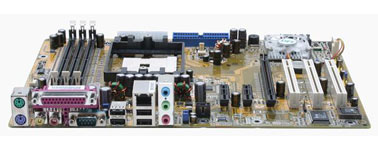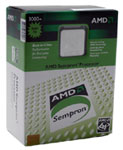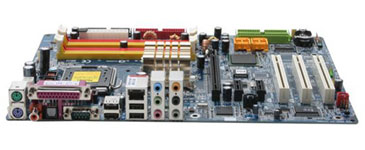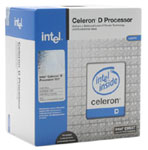Entry Level Buyer's Guide, October 2005
by Jarred Walton on October 14, 2005 12:05 AM EST- Posted in
- Guides
Gaming CPU and Motherboard Recommendations
The major change from the office configurations is going to be a move to discrete graphics, and in all instances, we're really interested in a motherboard that can overclock decently. You don't have to overclock, sure, but if you want higher performance from games and you can't afford a mid-range processor, a 25% or more overclock will certainly help. We've allocated an extra $250 for gaming purposes, and while the lion's share of that will go towards a good graphics card, an extra $40 or so on the motherboard and processor can also prove useful.
AMD Gaming Motherboard: DFI Infinity nF4X
Price: $77 shipped
AMD Gaming CPU: Sempron 64 (754) 3000+ - 128KB, 1.80 GHz Palermo
Price: $75 shipped (Retail)
Total: $152
The king of socket 754 overclocking is still the DFI LanParty UT nF3 250Gb. Unfortunately, there's a problem with that board: it's AGP only. If you already have a good AGP card and have been holding off upgrading, it might be worth considering - for example, an upgrade from an Athlon XP or older P4 system might benefit. A hybrid AGP/PCIe board like the ASRock would probably be a better choice, though - if only you could find such a board for socket 754. MSI makes the Neo3-F that has PCIe and the AGP-like AGR slot, but performance and compatibility of the AGR slot is not as good as what we would like. If you have a high-end AGP card, it will be a definite bottleneck, and if you have a low-end AGP card (9800 Pro or slower) and care about gaming, it's probably time to upgrade anyway.
In the end, most people will be better served by a PCIe-only motherboard, and happily, DFI has recently released their Infinity nF4X for socket 754 with options that nearly match the LanParty UT nF3. There are a few other boards that might work as well, including the ASUS K8N4-E Deluxe, EPoX EP-8NPA7I, and the Abit NV8. Since the Infinity 4X is the cheapest of the bunch and manages to overclock well, it gets our pick. Incidentally, if you want integrated Firewire, you only get one choice: the ASUS K8N4-E Deluxe. You could also go out and buy a Firewire card for the same $20, but then you're filling up one of three PCI slots.
For the processor, we remain in the same position as on the office computer: upgrading to Athlon 64 costs enough that you'd be better off moving to socket 939. For overclocking, we don't want to go lower than a 9X multiplier, but the 10X chips like the Sempron 3300+ and 3400+ are too expensive to justify. We're left with the choice between the 3000+ and the 3100+, with the 3100+ generally running about 5% faster due to the added L2 cache. As you can already see from our above selection, we chose the 3000+.
The total for motherboard and CPU comes to $152. Your best bet for a substantial performance upgrade would be to go with the motherboard and CPU that we used in our recent Venice Overclocking Guide. The DFI Infinity nF4 with a socket 939 Athlon 64 3000+ (retail) will cost about $240. The extra $88 will definitely get you to the point where the GPU will be your performance bottleneck, but you can get about the same performance from the Sempron 3000+. An ATI X800 Pro was basically CPU limited at resolutions starting at 1024x768 in our testing, whether we used a Venice 3000+ or a Palermo 3100+. (We'll have an article covering this in more detail soon; for now, you'll have to accept that statement without concrete numbers.)
Intel Office Motherboard: Gigabyte GA-8I945P-G
Price: $113 shipped
Intel Gaming CPU: Celeron D 331 - 256KB, 2.66 GHz Prescott
Price: $79 shipped (Retail)
Total: $192
As with the AMD configuration, we want a board that has some potential for overclocking. Whether or not you choose to use that potential is up to you, but the default CPU speeds for budget processors are pretty limiting. Gigabyte has done a fairly good job of catering to the performance and overclocking enthusiast, so we've upgraded from the ASUS Xpress 200 motherboard to a Gigabyte 945P motherboard. The change gets us four DDR2 DIMM slots, a robust set of overclocking options in the BIOS, and support for dual core Pentium D processors. It's doubtful that the Pentium D will ever reach the point where you would use it to upgrade this budget system, but once Presler launches in early 2006, we could see prices drop to the point where it would only be a $160 purchase. Regardless, we're more comfortable with Intel chipsets when overclocking than ATI chipsets - at least for the currently shipping models.
The CPU choice remains with the Celeron D 331, for price/performance reasons. Should you be interested in upgrading the CPU for more performance, the next chip that we would even consider would have to bear the Pentium name. The Pentium 506 runs at the same speed as the Celeron D 331, but it has four times the L2 cache and will end up around 10 to 15% faster (sometimes more) in almost every benchmark. Unfortunately, what we really want is a Pentium that still has HyperThreading support enabled, and those chips start at $160 instead of $110. We would recommend either living with the moderate performance of the Celeron D 331, or saving your pennies until you can afford a mid-range CPU and motherboard.
Overclocking of Pentium and Celeron D chips that have a default 533 FSB is somewhat interesting. The 20X multiplier is so high that Northbridge, RAM, and FSB limitations rarely come into play. What's needed is a BIOS that allows the user to modify the RAM speed to at least DDR-400, if not DDR-266. Using DDR2-533 RAM in combination with the 533FSB setting results in a 1:2 ratio (CPU:RAM), your RAM will likely move beyond its limit when overclocking. Dropping to the DDR-400 setting gives a 2:3 ratio, and this will allow up to a 178 MHz CPU bus speed without going out of spec on the RAM. If your CPU can handle that, you should end up with a respectable 3.56 GHz clock speed, and as with the overclocked AMD system, you will be largely bottlenecked by the GPU at that point. Note that in either case, the RAM will continue to run at a faster speed than the FSB, so you shouldn't encounter problems with asynchronous memory speeds.
The major change from the office configurations is going to be a move to discrete graphics, and in all instances, we're really interested in a motherboard that can overclock decently. You don't have to overclock, sure, but if you want higher performance from games and you can't afford a mid-range processor, a 25% or more overclock will certainly help. We've allocated an extra $250 for gaming purposes, and while the lion's share of that will go towards a good graphics card, an extra $40 or so on the motherboard and processor can also prove useful.
 |
 |
| Click images to enlarge. | |
AMD Gaming Motherboard: DFI Infinity nF4X
Price: $77 shipped
AMD Gaming CPU: Sempron 64 (754) 3000+ - 128KB, 1.80 GHz Palermo
Price: $75 shipped (Retail)
Total: $152
The king of socket 754 overclocking is still the DFI LanParty UT nF3 250Gb. Unfortunately, there's a problem with that board: it's AGP only. If you already have a good AGP card and have been holding off upgrading, it might be worth considering - for example, an upgrade from an Athlon XP or older P4 system might benefit. A hybrid AGP/PCIe board like the ASRock would probably be a better choice, though - if only you could find such a board for socket 754. MSI makes the Neo3-F that has PCIe and the AGP-like AGR slot, but performance and compatibility of the AGR slot is not as good as what we would like. If you have a high-end AGP card, it will be a definite bottleneck, and if you have a low-end AGP card (9800 Pro or slower) and care about gaming, it's probably time to upgrade anyway.
In the end, most people will be better served by a PCIe-only motherboard, and happily, DFI has recently released their Infinity nF4X for socket 754 with options that nearly match the LanParty UT nF3. There are a few other boards that might work as well, including the ASUS K8N4-E Deluxe, EPoX EP-8NPA7I, and the Abit NV8. Since the Infinity 4X is the cheapest of the bunch and manages to overclock well, it gets our pick. Incidentally, if you want integrated Firewire, you only get one choice: the ASUS K8N4-E Deluxe. You could also go out and buy a Firewire card for the same $20, but then you're filling up one of three PCI slots.
For the processor, we remain in the same position as on the office computer: upgrading to Athlon 64 costs enough that you'd be better off moving to socket 939. For overclocking, we don't want to go lower than a 9X multiplier, but the 10X chips like the Sempron 3300+ and 3400+ are too expensive to justify. We're left with the choice between the 3000+ and the 3100+, with the 3100+ generally running about 5% faster due to the added L2 cache. As you can already see from our above selection, we chose the 3000+.
The total for motherboard and CPU comes to $152. Your best bet for a substantial performance upgrade would be to go with the motherboard and CPU that we used in our recent Venice Overclocking Guide. The DFI Infinity nF4 with a socket 939 Athlon 64 3000+ (retail) will cost about $240. The extra $88 will definitely get you to the point where the GPU will be your performance bottleneck, but you can get about the same performance from the Sempron 3000+. An ATI X800 Pro was basically CPU limited at resolutions starting at 1024x768 in our testing, whether we used a Venice 3000+ or a Palermo 3100+. (We'll have an article covering this in more detail soon; for now, you'll have to accept that statement without concrete numbers.)
 |
 |
| Click images to enlarge. | |
Intel Office Motherboard: Gigabyte GA-8I945P-G
Price: $113 shipped
Intel Gaming CPU: Celeron D 331 - 256KB, 2.66 GHz Prescott
Price: $79 shipped (Retail)
Total: $192
As with the AMD configuration, we want a board that has some potential for overclocking. Whether or not you choose to use that potential is up to you, but the default CPU speeds for budget processors are pretty limiting. Gigabyte has done a fairly good job of catering to the performance and overclocking enthusiast, so we've upgraded from the ASUS Xpress 200 motherboard to a Gigabyte 945P motherboard. The change gets us four DDR2 DIMM slots, a robust set of overclocking options in the BIOS, and support for dual core Pentium D processors. It's doubtful that the Pentium D will ever reach the point where you would use it to upgrade this budget system, but once Presler launches in early 2006, we could see prices drop to the point where it would only be a $160 purchase. Regardless, we're more comfortable with Intel chipsets when overclocking than ATI chipsets - at least for the currently shipping models.
The CPU choice remains with the Celeron D 331, for price/performance reasons. Should you be interested in upgrading the CPU for more performance, the next chip that we would even consider would have to bear the Pentium name. The Pentium 506 runs at the same speed as the Celeron D 331, but it has four times the L2 cache and will end up around 10 to 15% faster (sometimes more) in almost every benchmark. Unfortunately, what we really want is a Pentium that still has HyperThreading support enabled, and those chips start at $160 instead of $110. We would recommend either living with the moderate performance of the Celeron D 331, or saving your pennies until you can afford a mid-range CPU and motherboard.
Overclocking of Pentium and Celeron D chips that have a default 533 FSB is somewhat interesting. The 20X multiplier is so high that Northbridge, RAM, and FSB limitations rarely come into play. What's needed is a BIOS that allows the user to modify the RAM speed to at least DDR-400, if not DDR-266. Using DDR2-533 RAM in combination with the 533FSB setting results in a 1:2 ratio (CPU:RAM), your RAM will likely move beyond its limit when overclocking. Dropping to the DDR-400 setting gives a 2:3 ratio, and this will allow up to a 178 MHz CPU bus speed without going out of spec on the RAM. If your CPU can handle that, you should end up with a respectable 3.56 GHz clock speed, and as with the overclocked AMD system, you will be largely bottlenecked by the GPU at that point. Note that in either case, the RAM will continue to run at a faster speed than the FSB, so you shouldn't encounter problems with asynchronous memory speeds.










35 Comments
View All Comments
i am getting angry - Friday, October 14, 2005 - link
As most of you known, I'm usually a big fan of Anandtech, however this time I couldn't disagree more!A "cheap/no name/ POS" PSU is an open inventation to every problem possible!
Very good PSU's can be had for under $30!
Cheap, but Good PSU's! [url]http://www.hardforum.com/showpost.php?p=1027898523...[/url]
I am "davidhammock200" however I couldn't login as me!
JarredWalton - Friday, October 14, 2005 - link
"A 'cheap/no name/POS' PSU is an open inventation to every problem possible!"It depends a lot on how high-end you go with parts. I've got a system sitting two feet from me with that MGE case and PSU. It's running at 2.70 GHz with a Sempron 3100+, and it's been running that way for three months. Did I get lucky? Maybe. More likely, people are just a little too concerned about power supplies and budget systems. $30 more would be enough to upgrade the 19" CRT to a 17" LCD - which do you think most people will choose?
I personally have never encountered instability that I would attribute to a PSU. I've had PSUs fail on numerous occasions, but in every case all it required was a new PSU. I've heard the stories of PSUs taking out the entire computer, and it's certainly possible in theory. I've never actually seen it happen, though.
Maybe I just care for my PCs too well? I do try to give them a good dusting every 3 months, which does wonders for fan life. I also don't try putting high-end builds with low end power. Low end parts with a low end PSU is exactly what you get from Dell and the likes, though. I've got a P4 2.8C Dell at my corporate job that has a 150W PSU. Amazing, eh? And it's been running 24/7 for over two years.
bldckstark - Friday, October 14, 2005 - link
If you want to get PO's about an article take a look at this one that is posted on THG. This is the most ridiculous thing I have ever read. They put together a MAJOR POS, don't use any logic, then also don't have any benchmarks to show what a piece it is. Take a look @ http://www.tomshardware.com/howto/20051014/index.h...">$500 gaming rig from THGYou may disagree with some of the picks here, but that whole system is crap. But at least they stayed in budget! I used to love THG, but now it is ridiculous. They have become a system buyer site, instead of a system builder site. It's like PCWorld bought them or something.
If you were going to build a system for $750, and you found you could build a significantly better one for $100 more wouldn't you do it? Hell, that is only 13%. I recently did the exact same thing. I got an SLI board cuz it was only $20 more. I got a 3200+ on a deal cuz it was only $15 more than the 3000+ on a package deal. I got a 6600GT even though they cost more than I originally thought. I got 512MB OCZ Platinum Rev2 ram cuz I can buy more later instead of 1GB of value ram now. I got a 300GB SATA drive cuz it was cheaper per GB than a 250, but it cost more too. Any project of any kind should have built in 10% contingency plan. In my lonely opinion Jarred is only liable for grief on the 3% over that. So here it is WAAaa.......... (3% of a whine).
bgladwyn - Friday, October 14, 2005 - link
It seems odd to include a speaker package with a subwoofer for an office setup when headphones would do. Similarly, flat panels are useful in the office because of the desk space they liberate. Lose the $37 speakers and shell out $199 for the cheapest 17" TFT on PriceGrabber and you have $33 well spent.JarredWalton - Friday, October 14, 2005 - link
When I say office in this guide, I mean "home office" as opposed to an actual workplace computer. For a workplace, speakers are generally frowned upon. There are many ways to get to an LCD, but quality is a bit more important than price if you're going that route. I'd forget about 15" LCDs and put 17" as the minimum, with a DVI input being preferred. Still, $200 for a 17" LCD isn't bad. $250 will even get you a 19" model, possibly with DVI.Like I said in the displays section, the only reason I didn't include an LCD was to get closer to the $500 price. I highly recommend anyone that can should spend more money on the display, with 19" LCDs being the ultimate goal.
bgladwyn - Friday, October 14, 2005 - link
Fair play, I've read all the article now(!) and can see that you'd already considered this point.ceefka - Friday, October 14, 2005 - link
Any expectations on integrated DVI graphics?I think that a 17" VGA LCD like the Samsung 710v (think it was 12 or 16ms) is quite OK for office use. Granted it is more expensive than a "comparable" CRT. It uses less juice, produces less heat and occupies less space, plus you actually work on that screen. My latest experience on a CRT was that after some time the numbers danced before my very eyes :D Just weigh that in and draw your own conclusions.
pcmatt1024 - Saturday, October 15, 2005 - link
i believe the new 6150 from nvidia (basically the higher end version of what was used on the amd office board) will have dvi out. boards should be out in the next few weeks.
JarredWalton - Saturday, October 15, 2005 - link
I can say for sure that the ATI Xpress 200 and Intel 915G both *can* support DVI output. The problem is that no motherboard manufacturers actually have such support so far. (I know that it's possible because I have two SFF cases with those chipsets, and they both have DVI ports.) Basically, DVI is a "high-end" option and IGP is often "value-oriented". It's sort of like the problem with uATX motherboards: no one makes an "enthusiast uATX" design; they're all built for value. And yes, there are some people that would like a high quality uATX mobo.PrinceGaz - Friday, October 14, 2005 - link
LCD panels are certainly getting better and I know for a fact that my next display (when this Mitsubishi DP 2070SB fails, which hopefully won't be for several years) won't be a CRT as there is already nothing available as good as it.If you were having problems using a CRT, then the refresh-rate was almost certainly too low. Windows 2000/XP defaults to 60hz which is unusable for most people for extended periods with a CRT monitor, and that is probably what you were using. Any half-decent CRT monitor will support at least 85hz at the ideal resolution, with which most people have no problems. Really good CRT monitors will support 100hz or more at their optimum resolutions, but unfortunately those really good CRT monitors can only be bought second-hand now as all the best manufacturers have switched to LCD panels.